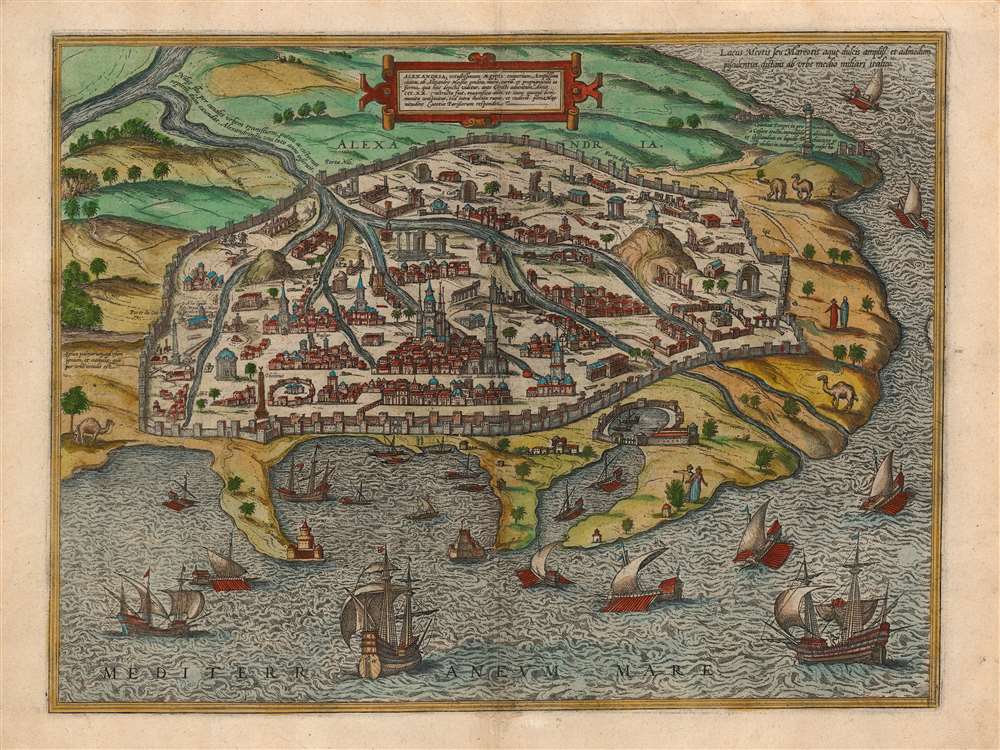This item has been sold, but you can get on the Waitlist to be notified if another example becomes available, or purchase a digital scan.
1575 Braun and Hogenberg View / Map of Alexandria, Egypt
Alexandria-braunhogenberg-1575-2
Title
1575 (undated) 14.25 x 18.75 in (36.195 x 47.625 cm)
Description
Looking at the View
Within the walls are many ruins, but the center of the city is commanded by the Abu al-Abbas al-Mursi Mosque and the multitude of houses, subordinate mosques and bazaar surrounding it indicate a thriving Muslim city. (Another structure is purported to have been the home of Alexander the Great, a nod to the founder of the city.) There are Christian elements shown as well: a church to St. Catherine (she of the Wheel), and a note by one ruin informs the reader that 'under this stone was found the body of Saint Mark; it is reported to be in Venice. On a promontory to the west, Pompey's pillar is shown and its 'incredible height and breadth' described. Canals are depicted bringing water from the Nile into the city year-round; another source of fresh water is noted in Lake Mariout: it is described as having abundant fresh water and many fish, being half an Italian mile distant from the city. (The adjective one now uses for Mariout is 'brackish.') Palm forests are noted as being used for fire, and for the sale of their wood. Overlooking the harbor can be seen the renowned Lighthouse of Pharos, one of the wonders of the ancient world - long gone by the time this view was issued. The harbor, and the Mediterranean Sea itself, teems with beautifully engraved sailing ships and rowing galleys.Publication History and Census
This view appeared in the second volume of the Civitates in 1575, and it was included in all four subsequent editions with no changes. The city books are well represented in institutional collections.CartographerS
Georg Braun (1541 – March 10, 1622) was a German deacon, viewmaker, and typo-geographer based in Cologne. Along with Franz Hogenberg (1535 - 1590), Braun is best known for his publication of the highly influential city atlas Civitates Orbis Terrarum. The six volume work, with some 546 views, was published between 1572 and 1617 and intended a companion to Abraham Ortelius' Theatrum Orbis Terrarum - thus certain obvious stylistic similarities. In compiling the Civitates Braun took on the role of editor while most of the engraving work was completed by Franz Hogenberg. Braun died, as he was born, in Cologne. More by this mapmaker...
Franz Hogenberg (1535 - 1590), often called 'Master Franz,' was a Flemish engraver active in the late 16th century. Hogenberg was born in Mechelen, the son of Nicolas Hogenberg, where he trained under the cartographer H. Terbruggen. He later relocated to Antwerp where he achieved success as an engraver, working with Abraham Ortelius, Hieronymus Cock, and others. In 1568, his name appeared on the list of those banned from the Netherlands by the Duke of Alva, forcing his family to flee to London. There he engraved for Christopher Saxon's Atlas of England and Wales. By 1570 he emigrated to Germany settling in Cologne. In Cologne he married his second wife, Agnes Lomar, with whom he had six children. In 1579 the couple were briefly imprisoned for holding illicit secret religious meetings, but were released in short order. Along with German cleric George Braun (1541 – March 10, 1622), Hogenberg issued the highly influential city atlas Civitates Orbis Terrarum. The six volume work, with some 546 views, was published between 1572 and 1617 and intended a companion to Abraham Ortelius' Thatrum Orbis Terrarum - thus certain obvious stylistic similarities. In compiling the Civitates Hogenberg took on the role of engraver while most of the editing was left to Georg Braun. Hogenberg died in Cologne, Germany, before the Civitates was completed. After his death, Hogenberg's work was continued by his son, Abraham Hogenberg, who, under the direction of Agnes, his mother, took over his father's enterprise at just 20. Learn More...

